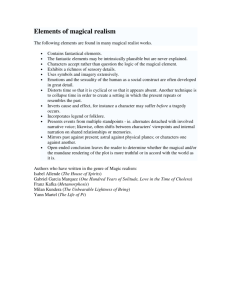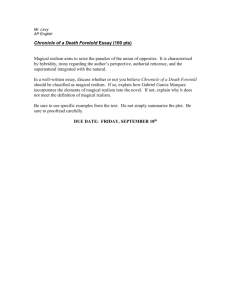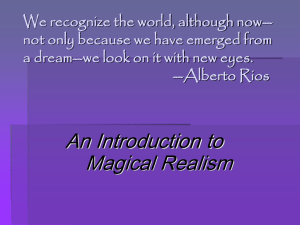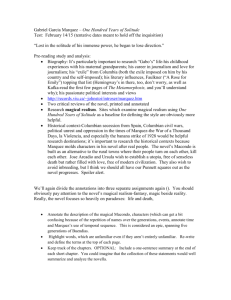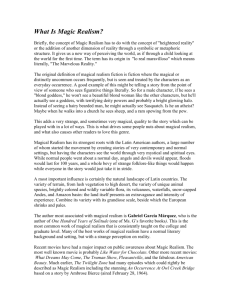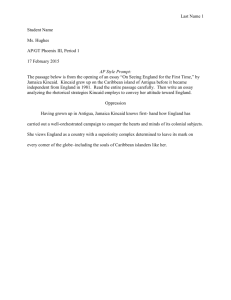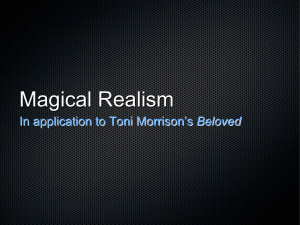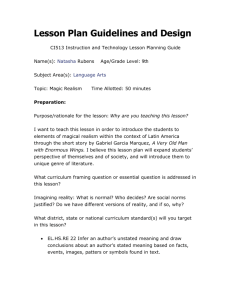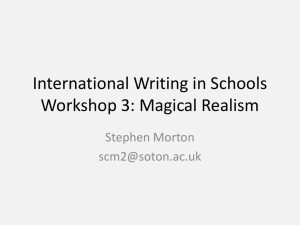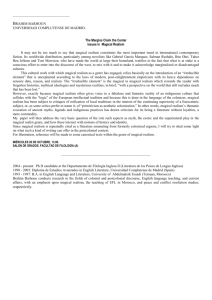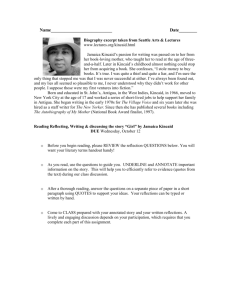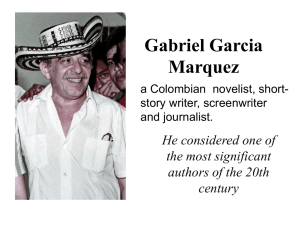Magical Realism_Marquez & Kincaid
advertisement
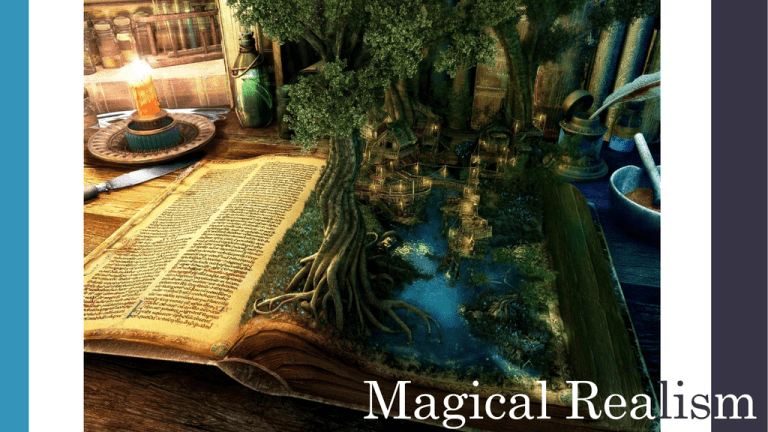
Magical Realism Magical Realism A literary mode rather than a distinguishable genre, magical realism is characterized by two conflicting perspectives, one based on a so-called rational view of reality and the other on the acceptance of the supernatural as prosaic reality. Magical Realism Magical realism differs from pure fantasy primarily because it is set in a normal, modern world with authentic descriptions of humans and society. It aims to seize the paradox of the union of opposites; for instance, it challenges binary oppositions like life and death and the pre-colonial past versus the post-industrial present. While the reader realizes that the rational and irrational are opposite and conflicting polarities, they are not disconcerted because the supernatural is integrated within the norms of perception of the narrator and characters in the fictional world. In short, In magical realism, the supernatural is not presented as questionable. Gabriel Garcia Marquez • Born March 6th, 1927 in Aracataca, Colombia. • Raised primarily by his maternal grandparents who inspired and encouraged him to become a writer. • Most of Marquez’ work is based off of what he witnessed in Colombia and the stories told by his grandparents. • Marquez rose to fame after the release of his most famous and critically acclaimed novel One Hundred Years of Solitude, defining his own literary style as Magical Realism with most of his works dealing with elements of fantasy and the surreal. Gabriel Garcia Marquez • Won the Neustadt International Prize for Literature in 1972. • Won the Nobel Prize in Literature in 1982. The Handsomest Drowned Man in the World 1) What was your overall interpretation of this story? 2) Comparing and contrasting the ways in which the children, women, and men react to the drowned man: How do you account for the differences in their reactions? 3) How does the drowned man’s stature contrast with the dimensions of the village? 4) What does the drowned man come to symbolize for the people of the village? The Handsomest Drowned Man in the World 1) How is the nature of the village’s transformation hinted at in the story’s subtitle, A Tale For Children? 2) Do you think that ‘magical realism’ is a good description of Marquez’ style in this story? Explain. 3) Philosophers have sometimes expressed the idea that the key to releasing human potential is to expand people’s imaginations. Explain how this story supports that notion. Artist, Josie Portillo Jamaica Kincaid • Born Elaine Cynthia Potter Richardson, May 25th, 1949 in St. John’s, Antigua. • Her mother was a home-maker and her step-father a carpenter. At age 17 she was sent to New York to work as an au pair. • Her novels are loosely autobiographical, though Kincaid has warned against interpreting their autobiographical elements too literally: "Everything I say is true, and everything I say is not true. You couldn't admit any of it to a court of law. It would not be good evidence.“ • Her work often prioritizes "impressions and feelings over plot development” and features conflict with both a strong maternal figure and colonial and neocolonial influences. Jamaica Kincaid Jamaica Kincaid’s passion for writing was passed on to her from her book-loving mother, who taught her to read at the age of three-and-a-half. Later in Kincaid’s childhood almost nothing could stop her from acquiring a book. She confesses, “I stole money to buy books. It’s true. I was quite a thief and quite a liar, and I’m sure the only thing that stopped me was that I was never successful at either. I’ve always been found out, and my lies all seemed so plausible to me, I never understood why they didn’t work for other people. I suppose those were my first ventures into fiction.” • 1985 Guggenheim Award for Fiction “Girl” 1) In the story “Girl,” Kincaid does not name the characters nor does she identify who they are and how they are related to each other. What do you think the relationship is between the two characters? 2) If the girl in "Girl" were a boy, what would Mom be telling him? What if Dad were talking instead? 3) Why is Mom so obsessed with her daughter's sexuality? Can you see parallels in today’s world? “Girl” 1) In your own life, what expectations are you grateful for that others place on you? 2) What expectations do you wish others did not place on you? 3) Did this story leave you with any questions? Artist, Jan Farara
